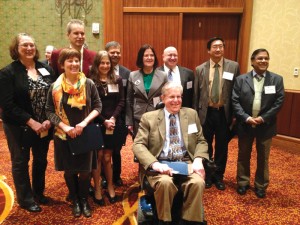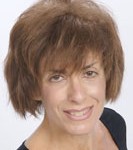Statistics and Scientists: Raising Awareness Through AAAS

ASA members who recently became AAAS Fellows include (from left): Katherine Ensor, Arlene Ash, Marc Genton, Karen Kafadar, Allan Sampson, Haikady Nagaraja, Nell Sedransk, Ron Wasserstein, Weng Kee Wong, and Nitis Mukhopadhyay.
A little over two years ago, I walked down the hall to find the February 11, 2011, issue of Science in my mailbox. I was excited to see the word “data” in an enormous font on the cover, overlaying a word cloud that also included “research,” “analysis,” “model,” and “knowledge,” highlighting the issue’s special section on dealing with data. An introduction by the Science staff indicated the goal was “to provide a broad look at the issues surrounding the increasingly huge influx of research data.” They spoke of the tremendous opportunities presented by the “data deluge” and reported that responders to a recent Science poll noted they “seek or would like additional help in analyzing” data.
But examination of the special section led to dismay. Mentions of statistics or statisticians were scant. It wasn’t long before I heard from equally disheartened friends. And this wasn’t the first time; an issue of Nature featuring Big Data a few years earlier had a similar dearth of references to statistics.
Lack of visibility is nothing new to our field; in fact, one of the themes of the ASA Strategic Plan is Increasing Visibility of the Profession. The Science issue highlighted starkly the magnitude of this challenge. Science is published by the American Association for the Advancement of Science (AAAS), the world’s largest general scientific society, with members from all walks of science (including statistics). Thus, the notable absence of statistics from the “data” issue might reflect broad lack of recognition across the spectrum of sciences and scientists.
Indeed, it might. Shortly thereafter, ASA representatives met with AAAS Executive Director Alan Leshner. He was candid, telling them his impression was that scientists view statistics not so much as a science but as a “bag of tools.” He went on to remark that “you have a visibility problem in Science and AAAS.”
We could simply get angry (really angry) at this mischaracterization of our field and reject the messenger. But statistics has too much to offer science, particularly in this era of massive and complex data—our unique skills in statistical modeling and design, understanding of uncertainty, and knowledge of the potential for bias and false discovery.
Which led me to one of my presidential initiatives. Elevating the visibility of our discipline across all of science is a formidable challenge. But a concrete first step could, and must, be taken. With nearly 120,000 individual and institutional members, 261 affiliated scientific societies (including the ASA), and 24 sections corresponding to fields of science—including Section U (statistics)—AAAS is a focal point for science. Increasing awareness within AAAS would be a key advance that could translate more broadly.
I asked Section U officers and ASA representatives to other sections of AAAS to form a workgroup and undertake activities to raise our profile. An immediate success was the selection of six invited session proposals sponsored by Section U in a highly competitive process across all areas of science to appear on the program of the annual AAAS meeting held in Boston in February (more in a moment).
The workgroup argued that increased participation by statisticians, commensurate to that of other scientists, would elevate the stature of statistical science within AAAS. They launched an effort to encourage students to enter the very competitive student poster competition. At the AAAS meeting, at least 10 of the winning 142 posters from all areas of science were from statistics students, an impressive first showing given the diversity of competition. In fact, students Kristin Linn of North Carolina State University and Stefa Etchegaray of Carnegie Mellon were two of only four winners of the prestigious Joshua Neimark Travel Award!
Noting that 2012 was the 50th anniversary of the founding of Section U, led by Section U secretary Jane Pendergast working with AAAS member services director Ian King, the group spearheaded an awareness campaign for JSM 2012. AAAS contributed 1,000 buttons displaying the logo shown here, which were distributed in San Diego along with fliers describing the benefits of AAAS membership. Many of you sported buttons during JSM, and we continue to distribute them at other events. The group followed with a December 2012 Amstat News article encouraging statisticians to emphasize the importance of statistics to fellow scientists through joining AAAS.
These efforts appear to have been effective. From February 2012 to February 2013, overall membership in Section U increased from 1,713 to 1,961 (14%), with members declaring it their primary section going from 365 to 435.
Initiatives continue, including exploring an ASA-AAAS joint symposium, proposing articles on statistical science for the AAAS MemberCentral website, and developing invited session proposals for future AAAS meetings. And Section U continues to nominate accomplished statisticians as AAAS Fellows in recognition of their contributions to science; 18 were honored at the February AAAS meeting, some of whom are pictured here. The increase in Section U membership brought an increase in the number of Fellow nominations the section may support this year.
So, why should you join AAAS?
The altruistic reason is to join fellow statisticians in promoting the contributions of statistics to outstanding fellow scientists. With increased numbers will come the visibility that will allow us to advocate more forcefully for sound statistical design and analysis and appreciation for the value of statisticians.
But the personal benefits are equally significant. Membership brings access to an array of AAAS resources: webinars, blogs, science news, and, of course, Science. And, as I experienced firsthand in February, the AAAS meeting.
The annual AAAS meeting is similar in size to JSM, but serves a much broader audience. All sessions (symposia) are invited, and the concurrent number is small. Symposia must be accessible to a general scientific audience, and speakers must be outstanding presenters. Numerous general interest workshops and events are held, and there are scores of special lectures by eminent researchers. Opportunities to learn about new areas of science and identify challenges in which statistical science could contribute are substantial.
I attended several Section U–sponsored symposia, all with standing-room-only crowds, and left in awe of how much I learned. “The Science of Uncertainty in Genomic Medicine” featured point-counterpoint talks by two clinicians, one citing evidence for his contention that the genomic revolution has, as yet, led to only “feeble” ability to predict disease risk and may be encouraging overreactions and unnecessary interventions, and the other describing novel clinical trials to assess whether patient anxiety is unduly raised by knowledge of genetic predisposition carrying uncertain risk (the evidence suggests not).
“Understanding and Communicating Uncertainty in Climate Change Science” presenters described superbly how statistical modeling is used to combine data with climate models and quantify risk and the challenges of communicating the uncertainty in this complex enterprise to the public and policymakers. One speaker urged replacing assertions of causality by simple probabilistic comparisons to circumvent seeming inconsistencies in climate science analogous to the apparent contradiction that smoking “causes” cancer, but a politician’s two-pack-a-day grandfather could live to 97. Another encouraged climate scientists to develop relationships with decisionmakers and to not oversell science, but to translate its limitations and notions of risk and uncertainty into terms they can understand. A discussion about communicating science to policymakers with New York Times Dot Earth blogger Andrew Revkin followed.
One talk in “The Benefits of Randomized Experiments for Science and Society” session reported a study design used in political science to assess racial bias among white southerners. Subjects are randomized to two groups. One is presented a list of three innocuous events and asked, “How many of these upset you?” The other receives a list of four—the same three plus “A black family has moved in next door.” Subjects are asked to report only the number (but not nature) of upsetting items, and a larger average number in the second group is assumed to reflect the true proportion of subjects upset by the racially related event. I’ll leave it to my fellow statisticians to critique the design.
“A Decade After ‘Forensic Science: Oxymoron?’: Will There Be Real Change?” reviewed a 2009 National Research Council report that found a lack of statistical foundation for many U.S. forensic science practices and called for increased use of statistics to strengthen them. This session was held as the Department of Justice and National Institute of Standards and Technology announced formation of a National Commission on Forensic Science to address these issues.
I could write pages about the diverse scientific challenges discussed in these and other symposia and the critical role statistics has to play in all of them. The AAAS meeting offers a remarkable forum for statisticians to highlight that critical role.
I encourage you to join AAAS, choose Section U as your primary section, and become a partner in this effort to enhance awareness of our discipline. Together, we can dispel the notion of statistics as “a bag of tools.”


















